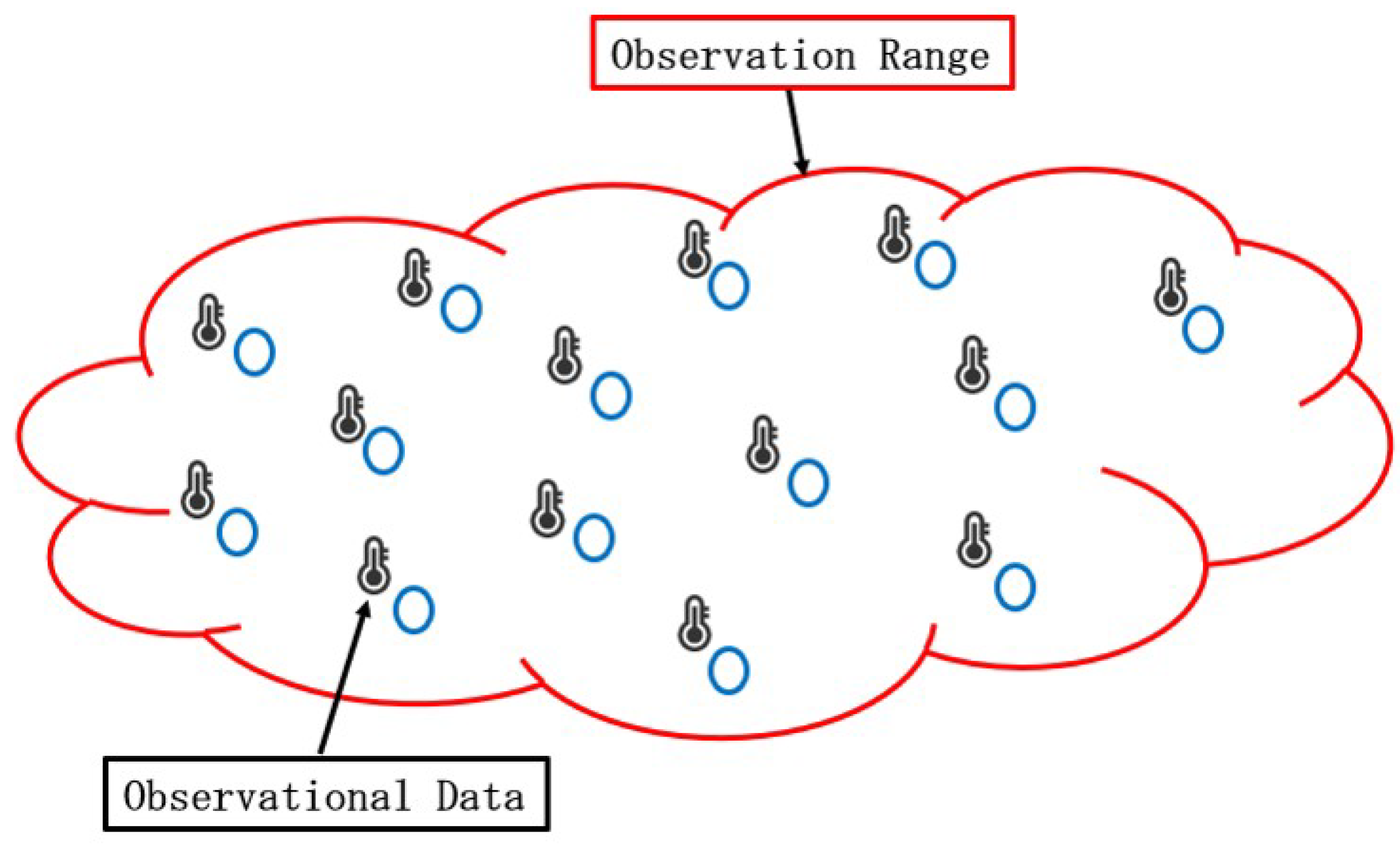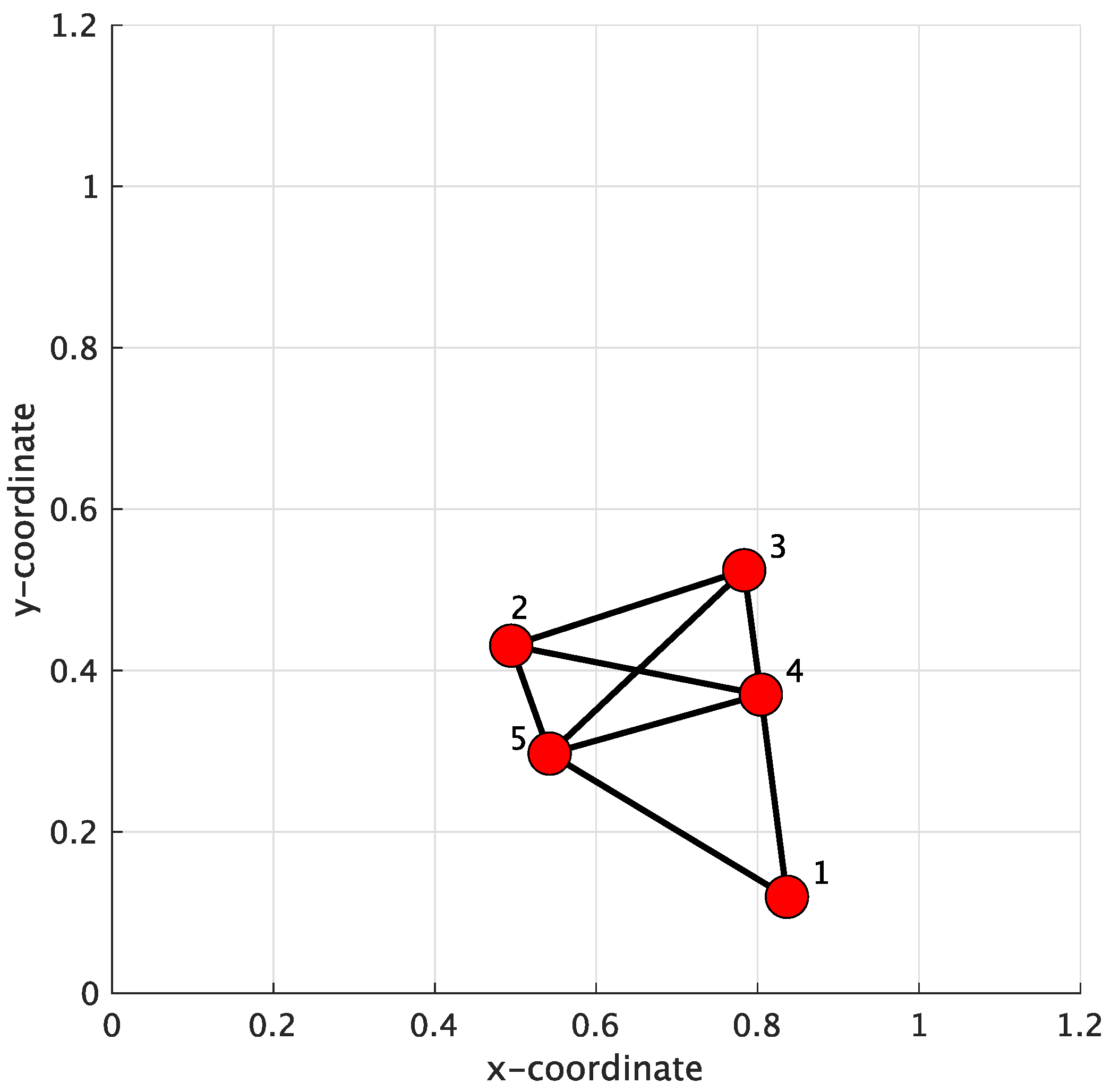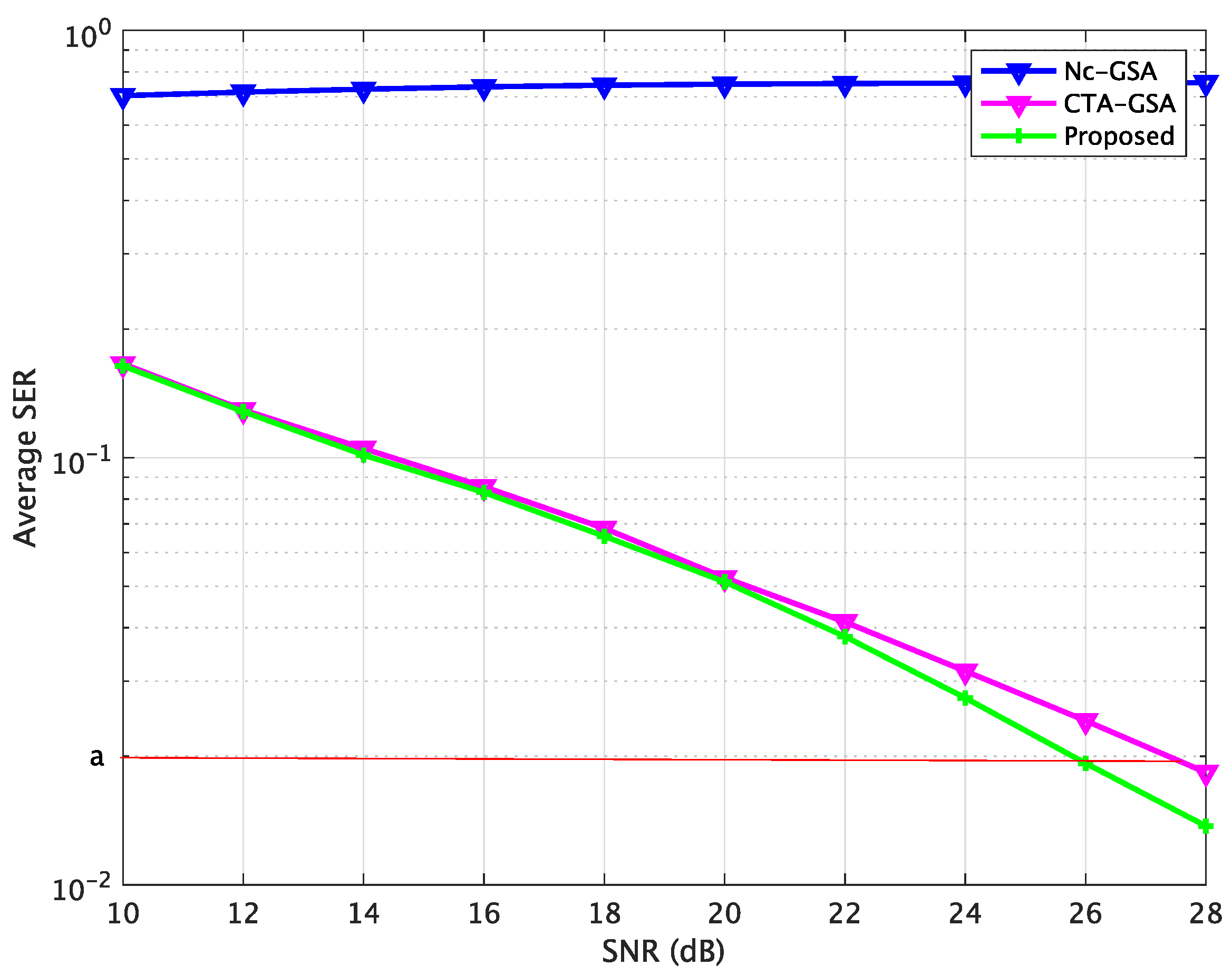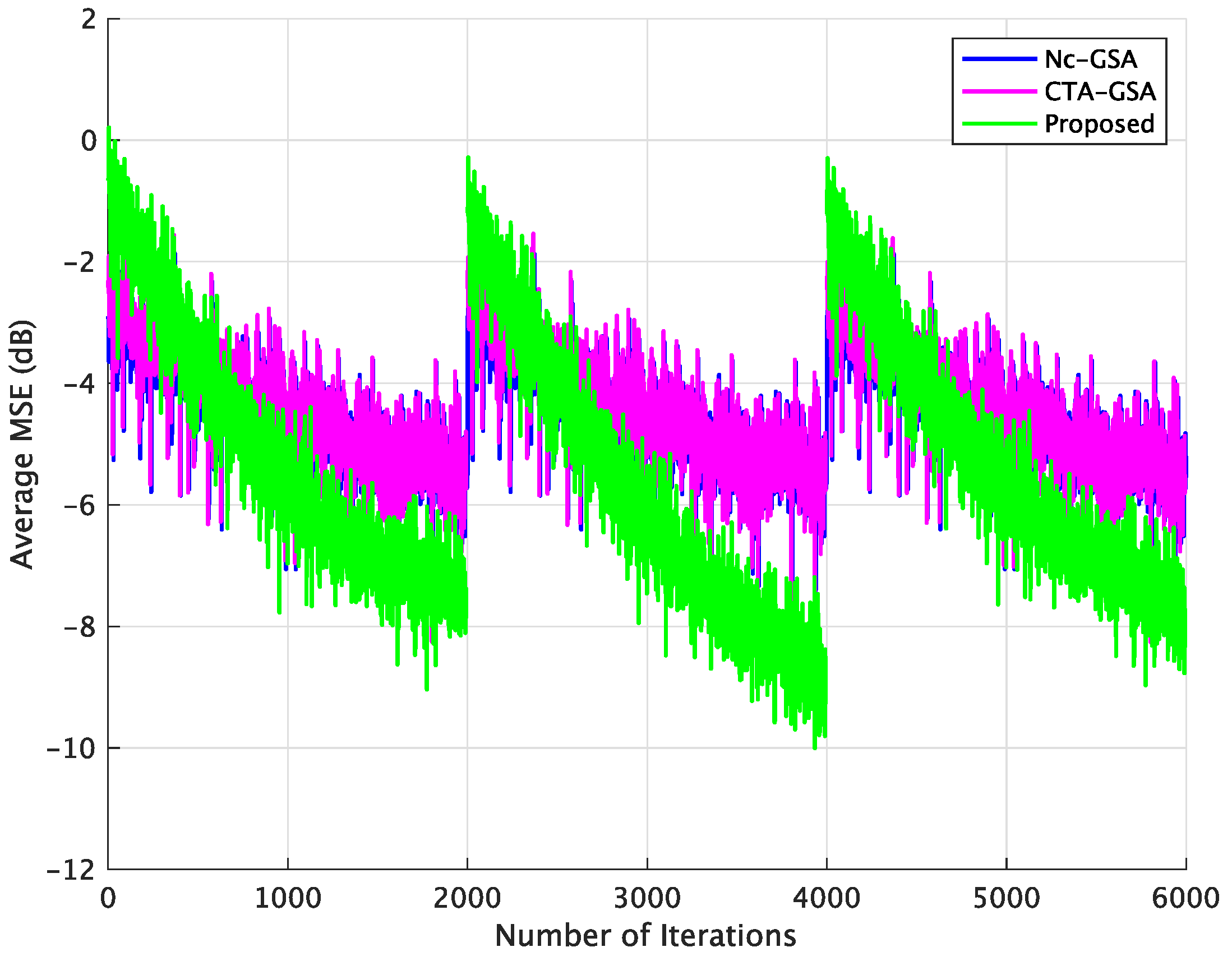Network Topology Reconfiguration-Based Blind Equalization over Sensor Network
Abstract
1. Introduction
2. System Model and Problem Formulation
3. Network Topology Reconfiguration Approach for Distributed Blind Estimation
3.1. Distributed Blind Equalization
3.2. Proposed Approach
3.2.1. Ill-Channel Detection
- The maximum condition number in the r-th LSN is calculated aswhere the function denotes the maximum function used to find the maximum value of all sensor nodes in the r-th LSN from the condition number vector ;
- The minimum condition number in the r-th LSN is calculated aswhere the function denotes the minimum function used to find the minimum value of the condition number in the r-th LSN;
- The ill-channel is detected for the current LSN by comparing the maximum and minimum condition numbers.where the function means that the comparison between the maximum and minimum values, is a positive constant, which satisfies . If the value of is greater than , then we consider those sensor nodes corresponding to ill-channels, where the condition numbers of sensor nodes are larger than . Consequently, the weights of those sensor nodes are set as 0. On the other hand, if the value of is less than or equal to , then the sensor node with the value is defined as the ill-channel. For example, in Figure 4, if the neighbor m of the sensor node r is detected to correspond to an ill-channel in the r-th LSN, the weight of the sensor node m is set as 0, (). Moreover, a value of closer to 1 makes the system more sensitive to ill-channels. However, in each LSN, if , only the best channel can be used for signal estimation, leading to increased power consumption of the sensor node. In order to avoid this situation, an appropriate needs to be chosen.
3.2.2. Weight Assignment
4. Simulation Experiments
5. Conclusions
Author Contributions
Funding
Institutional Review Board Statement
Informed Consent Statement
Data Availability Statement
Conflicts of Interest
References
- Lopes, C.G.; Sayed, A.H. Incremental adaptive strategies over distributed networks. IEEE Trans. Signal Process 2007, 55, 4064–4077. [Google Scholar] [CrossRef]
- Liu, Y.; Li, L. Distributed Blind Estimation Over Sensor Networks. IEEE Access 2017, 5, 18343–18355. [Google Scholar] [CrossRef]
- Sayed, A.H.; Lopes, C.G. Adaptive processing over distributed networks. IEICE Trans. Fundam. Electron. Commun. Comput. Sci. 2007, 90, 1504–1510. [Google Scholar] [CrossRef]
- Liu, Y.; Tang, W.K.S. Enhanced incremental LMS with norm constraints for distributed in-network estimation. Signal Process 2014, 94, 373–385. [Google Scholar] [CrossRef]
- Li, L.; Chambers, J.A.; Lopes, C.G.; Sayed, A.H. Distributed estimation over an adaptive incremental network based on the affine projection algorithm. IEEE Trans. Signal Process 2010, 58, 151–164. [Google Scholar] [CrossRef]
- Lopes, C.G.; Sayed, A.H. Diffusion least-mean squares over adaptive networks: Formulation and performance analysis. IEEE Trans. Signal Process 2008, 56, 3122–3136. [Google Scholar] [CrossRef]
- Liu, Y.; Li, C.; Zhang, Z. Diffusion sparse least-mean squares over networks. IEEE Trans. Signal Process 2012, 60, 4480–4485. [Google Scholar] [CrossRef]
- Cattivelli, F.S.; Sayed, A.H. Diffusion LMS strategies for distributed estimation. IEEE Trans. Signal Process 2010, 58, 1035–1048. [Google Scholar] [CrossRef]
- Liu, Z.; Liu, Y.; Li, C. Distributed sparse recursive least-squares over networks. IEEE Trans. Signal Process 2014, 62, 1386–1395. [Google Scholar] [CrossRef]
- Cattivelli, F.S.; Lopes, C.G.; Sayed, A.H. Diffusion recursive least squares for distributed estimation over adaptive networks. IEEE Trans. Signal Process 2008, 56, 1865–1877. [Google Scholar] [CrossRef]
- Abed-Meraim, K.; Qiu, W.; Hua, Y. Blind system identification. Proc. IEEE 1997, 85, 1310–1322. [Google Scholar] [CrossRef]
- Zhang, Y.B.; Zhao, J.W.; Guo, Y.C.; Li, J.M. Blind adaptive MMSE equalization of underwater acoustic channels based on the linear prediction method. J. Marine Sci. Appl. 2011, 10, 113–120. [Google Scholar] [CrossRef]
- Xiao, Y.; Li, M. Recursive least squares fractionally-spaced blind equalization algorithm for underwater acoustic communication. J. Inf. Comput. Sci. 2013, 10, 6077–6084. [Google Scholar] [CrossRef][Green Version]
- Abdolee, R.; Champagne, B. Distributed blind adaptive algorithms based on constant modulus for wireless sensor networks. In Proceedings of the 2010 6th International Conference on Wireless and Mobile Communications, Valencia, Spain, 20–25 September 2010; pp. 303–308. [Google Scholar]
- Yu, C.; Xie, L. On recursive blind equalization in sensor networks. IEEE Trans. Signal Process. 2015, 63, 662–672. [Google Scholar] [CrossRef]
- Ding, Z.; Li, Y. Blind Equalization and Indentification; Marcel Dekker: New York, NY, USA, 2001. [Google Scholar]
- Abrar, S.; Nandi, A.K. An adaptive constant modulus blind equalization algorithm and its stochastic stability analysis. IEEE Signal Process. Lett. 2010, 17, 55–58. [Google Scholar] [CrossRef]
- Rao, W.; Tan, W.Q.; Li, Y.M.; Gao, H.J. New modified constant modulus algorithm for underwater acoustic communications. In Proceedings of the 2011 International Conference on Internet Computing and Information Services, Hong Kong, China, 17–18 September 2011; pp. 563–566. [Google Scholar]
- Parvin, N.; Sugiura, T.; Shimamura, T. Blind equalization based on normalized error in wireless sensor networks. J. Signal Process. 2019, 23, 215–225. [Google Scholar] [CrossRef]
- Parvin, N.; Shimamura, T. Eigenvalue-spread-based combination rule for distributed blind equalization in networked system. J. Signal Process. 2019, 23, 243–256. [Google Scholar] [CrossRef]
- Chi, S.; Shimamura, T. A combination rule based on signal power for distributed blind equalization. In Proceedings of the 20th International Symposium on Communications and Information Technologies (ISCIT), Tottori, Japan, 19–22 October 2021; pp. 199–203. [Google Scholar]
- Chi, S.; Shimamura, T. Signal-power-based combination weight rule for distributed blind equalization in WSN model. J. Signal Process. 2023, 27, 35–46. [Google Scholar] [CrossRef]
- Chi, S.; Sugiura, Y.; Shimamura, T. Distributed blind equalization with block-adaptive approach on wireless sensor network. In Proceedings of the IEEE SENSORS 2023, Vienna, Austria, 29 October–1 November 2023; pp. 1–4. [Google Scholar]
- Chi, S.; Shimamura, T. Distributed Blind Equalization Based on the Best Local Network in Networked System. J. Signal Process. 2023, 27, 165–177. [Google Scholar] [CrossRef]
- Lu, W.; Mo, Y.; Feng, Y.; Gao, Y.; Zhao, N.; Wu, Y.; Nallanathan, A. Secure transmission for multi-UAV-assisted mobile edge computing based on reinforcement learning. IEEE Tran. Netw. Sci. Eng. 2023, 10, 1270–1282. [Google Scholar] [CrossRef]
- Zeng, Y.; Tang, J. MEC-assisted real-time data acquisition and processing for UAV with general missions. IEEE Trans. Veh. Technol. 2023, 72, 1058–1072. [Google Scholar] [CrossRef]
- Chen, J.; Tang, J. UAV-assisted data collection for wireless sensor networks with dynamic working modes. Digit. Commun. Netw. 2022, 10, 805–812. [Google Scholar] [CrossRef]
- Wei, Z.; Zhu, M.; Zhang, N.; Wang, L.; Zou, Y.; Meng, Z.; Wu, H.; Feng, Z. UAV-assisted data collection for internet of things: A survey. IEEE Internet Things J. 2022, 9, 15460–15483. [Google Scholar] [CrossRef]
- Draper, S.C.; Frey, B.J.; Kschischang, F.R. Interactive decoding of a broadcast message. In Proceedings of the 41st Annual Allerton Conference on Communication, Control, and Computing, Monticello, IL, USA, 1 October 2003; pp. 1–11. [Google Scholar]
- Dabora, R.; Servetto, S.D. Broadcast channels with cooperating decoders. IEEE Trans. Inf. Theory 2006, 52, 5438–5454. [Google Scholar] [CrossRef]
- Liu, Y.; Cai, Y. Distributed blind equalization in networked systems. In Proceedings of the 2017 IEEE International Conference on Acoustics, Speech and Signal Processing (ICASSP), New Orleans, LA, USA, 5–9 March 2017; pp. 4296–4300. [Google Scholar]
- Xiao, L.; Boyd, S. Fast linear iterations for distributed averaging. Syst. Control Lett. 2004, 53, 65–78. [Google Scholar] [CrossRef]
- Hastings, W.K. Monte Carlo sampling methods using Markov chains and their applications. Biometrika 1970, 57, 97–109. [Google Scholar] [CrossRef]
- Chouvardas, S.; Slavakis, K.; Theodoridis, S. Adaptive robust distributed learning in diffusion sensor networks. IEEE Trans. Signal Process 2011, 59, 4692–4707. [Google Scholar] [CrossRef]
- Blondel, V.D.; Hendrickx, J.M.; Olshevsky, A.; Tsitsiklis, J.N. Convergence in multiagent coordination, consensus, and flocking. In Proceedings of the 44th IEEE Conference on Decision and Control, Seville, Spain, 15 December 2005; pp. 2996–3000. [Google Scholar]
- Schizas, I.D.; Mateos, G.; Giannakis, G.B. Distributed LMS for consensus-based in-network adaptive processing. IEEE Trans. Signal Process 2009, 8, 2365–2381. [Google Scholar] [CrossRef]
- Zhao, X.; Sayed, A.H. Performance limits for distributed estimation over LMS adaptive networks. IEEE Trans. Signal Process 2012, 60, 5107–5124. [Google Scholar] [CrossRef]
- Salman, T.; Badawy, A.; Elfouly, T.M.; Khattab, T.; Mohamed, A. Non-data-aided SNR estimation for QPSK modulation in AWGN channel. In Proceedings of the IEEE 10th International Conference on Wireless and Mobile Computing, Networking and Communications (WiMob), Larnaca, Cyprus, 8–10 October 2014; pp. 611–616. [Google Scholar]
- Papadopoulos, P.; Tsiartas, A.; Narayanan, S. LongTerm SNR Estimation of Speech Signals in Known and Unknown Channel Conditions. IEEE/ACM Trans. Audio Speech Lang. Process. 2016, 24, 2495–2506. [Google Scholar] [CrossRef]
- Ahn, D.; Lee, J.; Shin, S.J.; Song, W. A new robust variable weighting coefficients diffusion LMS algorithm. Signal Process 2017, 131, 300–306. [Google Scholar] [CrossRef]
- Parter, S.V. On the extreme eigenvalues of truncated toeplitz matrices. Bull. Am. Math. Soc. 1961, 67, 191–196. [Google Scholar] [CrossRef]
- Kesten, H. On the extreme eigenvalues of translation kernels and toeplitz matrices. J. d’Analyse Math. 1962, 10, 117–138. [Google Scholar] [CrossRef]
- Haykin, S. Adaptive Filter Theory; Prentice Hall: Saddle River, NJ, USA, 1996. [Google Scholar]












| Methods | Complex Multiplications | Complex Additions |
|---|---|---|
| CTA-GSA | ||
| Proposed |
| 0.6000 | 0 | 0 | 0.2000 | 0.2000 |
| 0 | 0.3500 | 0.2500 | 0.2000 | 0.2000 |
| 0 | 0.2500 | 0.3500 | 0.2000 | 0.2000 |
| 0.2000 | 0.2000 | 0.2000 | 0.2000 | 0.2000 |
| 0.2000 | 0.2000 | 0.2000 | 0.2000 | 0.2000 |
| Nc-Gsa | CTA-GSA | Proposed | |
|---|---|---|---|
| SER(%) | 0.7547 | 0.0183 | 0.0137 |
| Nc-GSA | CTA-GSA | Proposed | |
|---|---|---|---|
| SER(%) | 0.7559 | 0.0230 | 0.0183 |
Disclaimer/Publisher’s Note: The statements, opinions and data contained in all publications are solely those of the individual author(s) and contributor(s) and not of MDPI and/or the editor(s). MDPI and/or the editor(s) disclaim responsibility for any injury to people or property resulting from any ideas, methods, instructions or products referred to in the content. |
© 2024 by the authors. Licensee MDPI, Basel, Switzerland. This article is an open access article distributed under the terms and conditions of the Creative Commons Attribution (CC BY) license (https://creativecommons.org/licenses/by/4.0/).
Share and Cite
Sulin, C.; Tetsuya, S. Network Topology Reconfiguration-Based Blind Equalization over Sensor Network. Sensors 2024, 24, 4524. https://doi.org/10.3390/s24144524
Sulin C, Tetsuya S. Network Topology Reconfiguration-Based Blind Equalization over Sensor Network. Sensors. 2024; 24(14):4524. https://doi.org/10.3390/s24144524
Chicago/Turabian StyleSulin, Chi, and Shimamura Tetsuya. 2024. "Network Topology Reconfiguration-Based Blind Equalization over Sensor Network" Sensors 24, no. 14: 4524. https://doi.org/10.3390/s24144524
APA StyleSulin, C., & Tetsuya, S. (2024). Network Topology Reconfiguration-Based Blind Equalization over Sensor Network. Sensors, 24(14), 4524. https://doi.org/10.3390/s24144524






